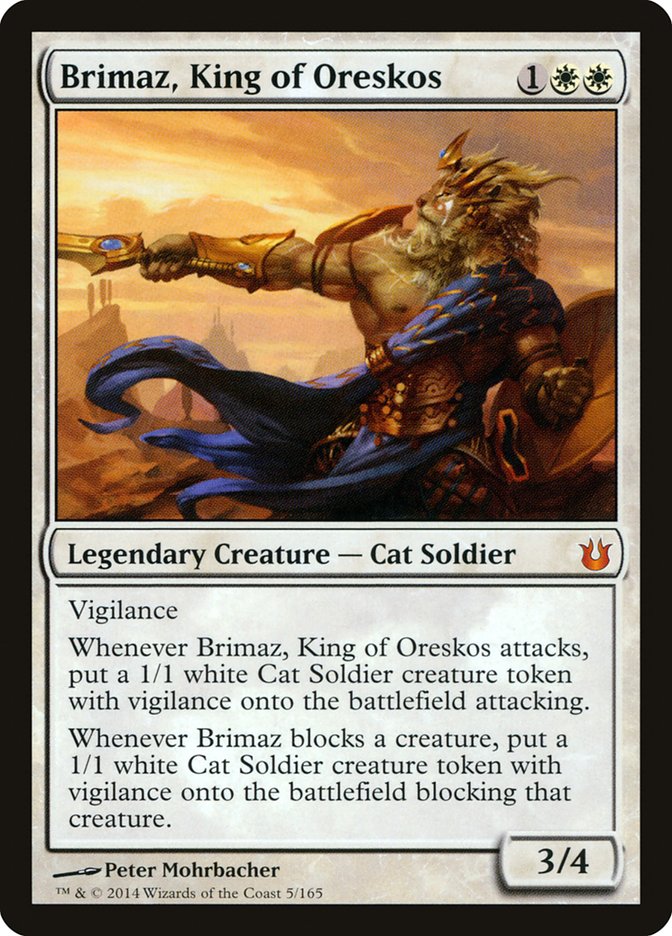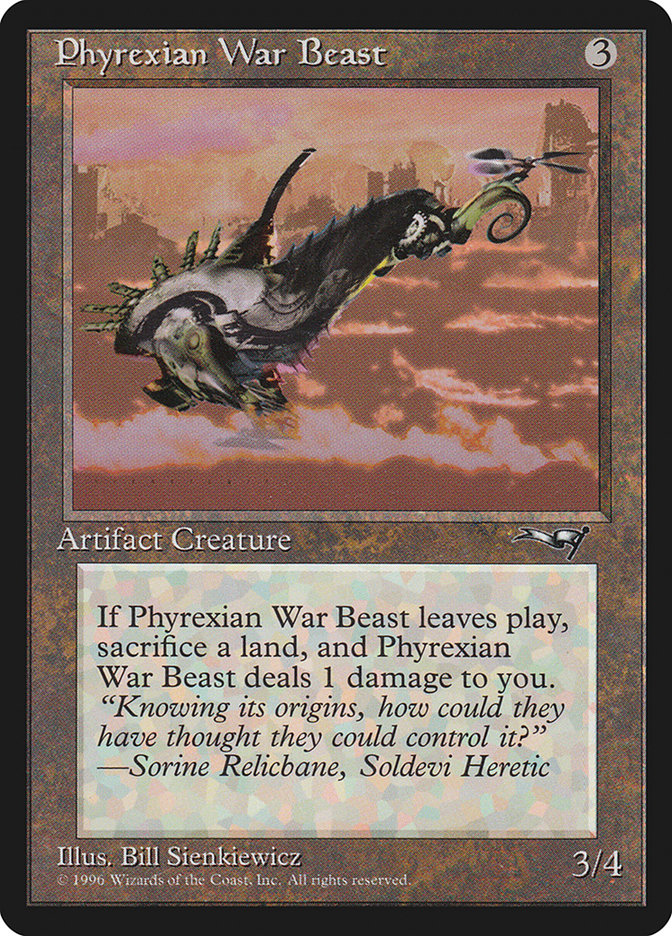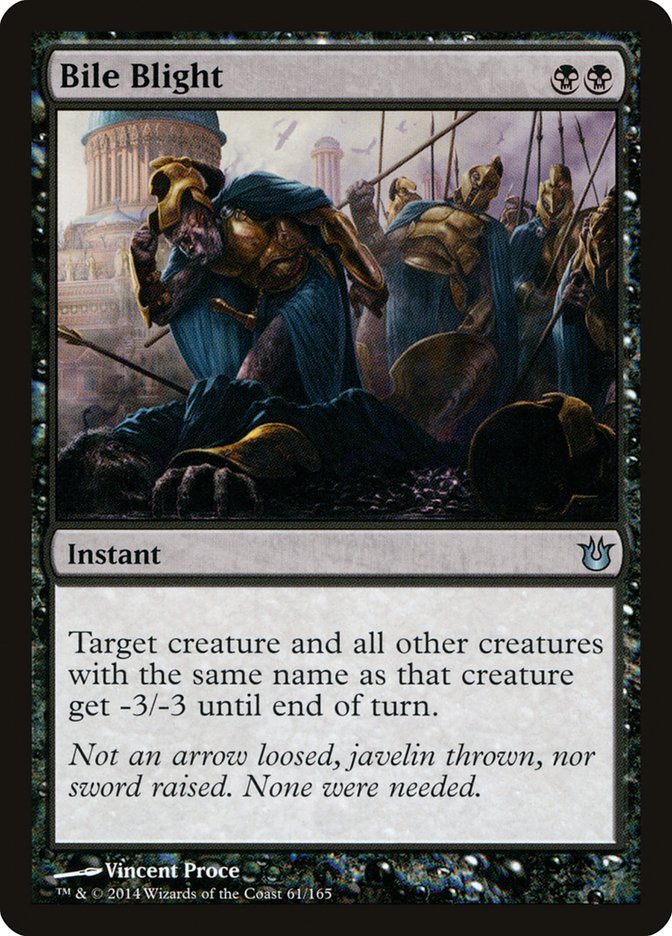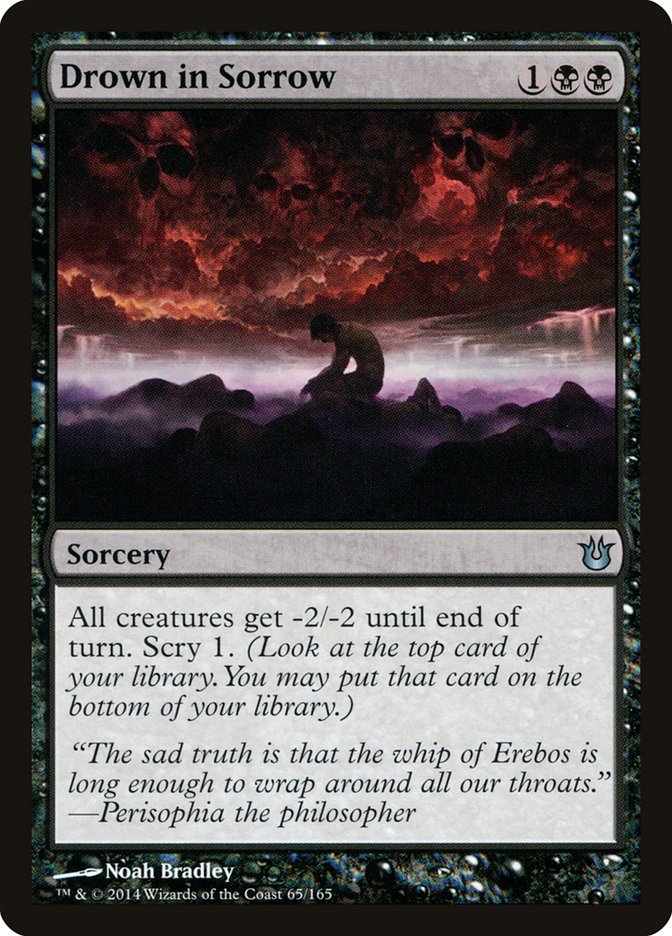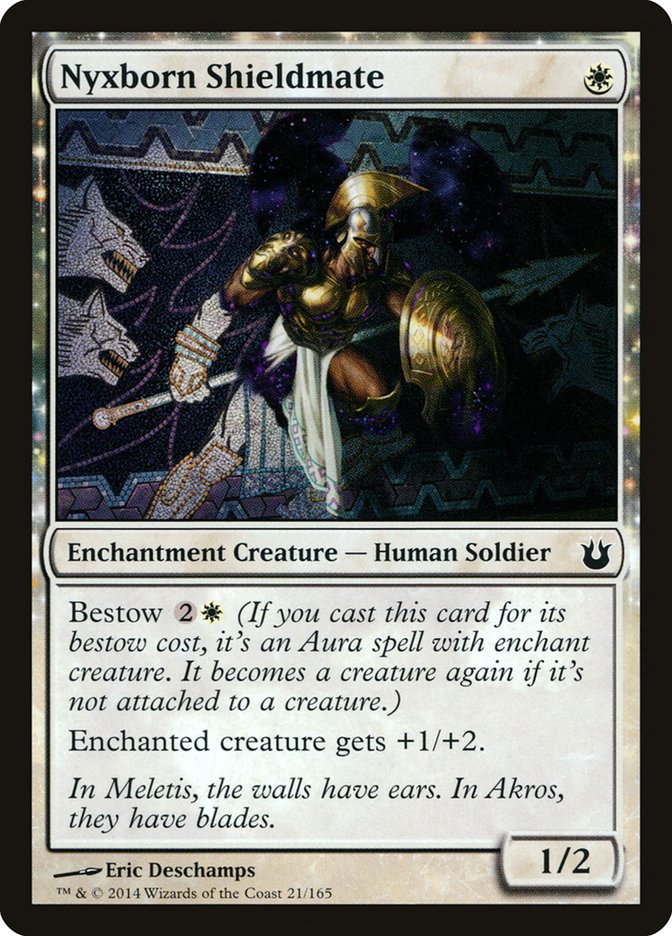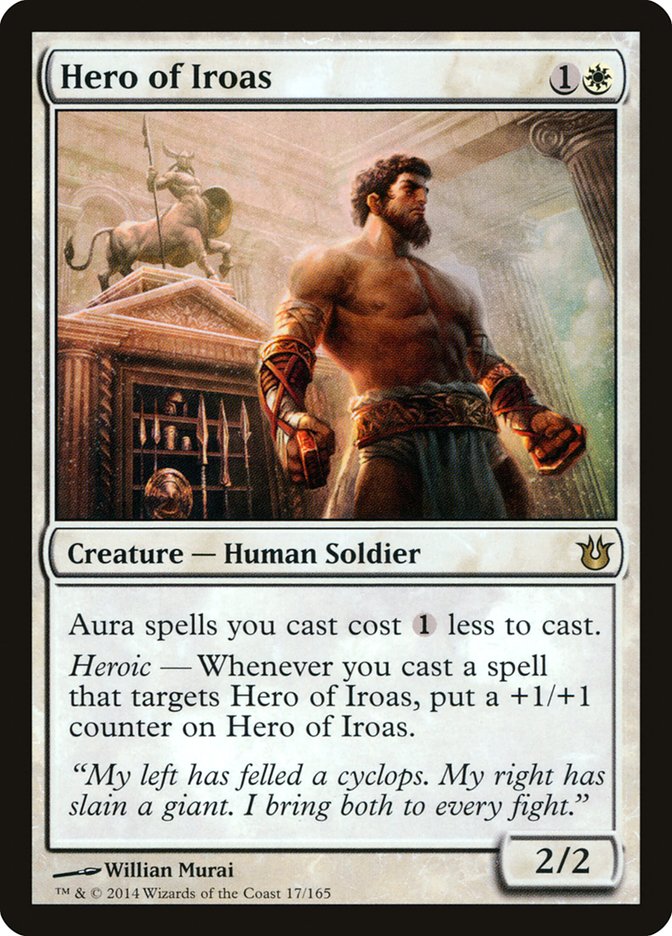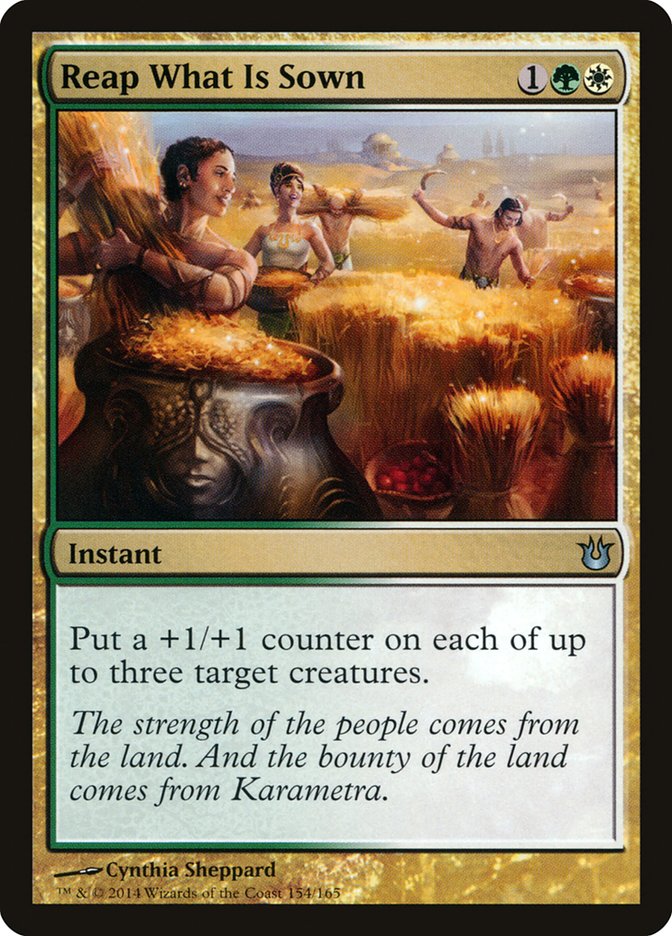This is not the most realistic Magic card ever printed—let’s just get that out of the way right now.
Born of the Gods spoiler season is in high gear, and with 54 cards previewed so far, there is one that head and shoulders above the rest.
I don’t know what’s in the water in Oreskos, but they’re definitely doing something right. The audacity of this card is pretty amusing. This is that special sort of mythic rare that makes you do a double take and kind of just ask, “Really? Really?”
I, for one, welcome our new cat king overlord.
Yeah? A 3/4 creature for three with three great abilities?
I remember when this little guy won the World Championship in a mono-white deck:
Yeah, yeah, yeah, I know. Creatures have gotten better, and the War Beast being colorless was a special ability in a world as heavily Black Knight oriented as 1996 was. The point still stands—Brimaz is in another galaxy regarding casting cost and mana efficiency.
In modern times, Loxodon Smiter is the gold standard for three-cost hard bodies. How does Brimaz measure up?
Well, to start with, Brimaz attacks for four just like the Smiter. He gets shut down by 4/4s (like the Smiter), but on the flipside he’s harder to block (needing at least two creatures to prevent all of his damage). Is making an extra 1/1 better than just having the +1 power in the first place?
Overall, yes by a good clear margin. To begin with, every time the tokens don’t get eaten, they start to stack up. Just compare their goldfishes:
Smiter
Turn 4: 4
Turn 5: 8
Turn 6: 12
Turn 7: 16
Turn 8: 20
Brimaz
Turn 4: 4
Turn 5: 9
Turn 6: 15
Turn 7: 22
Brimaz kills a full turn faster than Smiter, and more importantly even if they eventually draw an answer, if it isn’t a sweeper they’re still in big trouble. Loxodon Smiter can be shut down by a single Doom Blade even if it already hit you four times.
Brimaz’s “Dervish” ability is certainly not the only reason a 1/1 is better than a +1/+1 counter here. Spear of Heliod and other pump affects combine extremely well with Brimaz. Play Brimaz on 3 and Spear on 4 and you’re looking at:
Turn 4: 6
Turn 5: 14
Turn 6: 24
If you played basically anything during the first two turns, that is a turn 5 kill. Curve out and we even have chances at a turn 4 kill.
Extra Spear pumps are just the beginning though. The extra body means that Brimaz can turn on any battalion creature singlehandedly. Boros Elite, Daring Skyjek, Frontline Medic, Legion Loyalist, Firefist Striker, and the rest are all a little stronger.
Of course, Loxodon Smiter isn’t the real comparison everyone’s making. A 3/4 white creature that makes tokens? How can you not compare Brimaz to Hero of Bladehold?
Numbers and color and theme aside, they really are very similar cards at their core. However, isn’t Hero of Bladehold nearly twice the man Brimaz is? After all, he makes tokens twice as fast and attacks for seven and then eleven.
A few points of order:
To begin with, Brimaz costs one mana less. This is a really big deal. It’s not just an extra turn of attack and token making. Yes, they both goldfish on turn 7 by themselves, but that’s not the point. Costing only three mana means you might have Brimaz for several turns earlier if you don’t draw your fourth land.
It means he can defend you a turn earlier. It means you can often get an attack off before a sweeper. It means you can play Brimaz with Brave the Elements up when Hero of Bladehold would have been defenseless.
Now how does vigilance factor in? Hero of Bladehold didn’t have it, and there was a non-zero number of times where it actually had to stay home if the race was going poorly. That was never a good spot to be in, but it happened.
That Brimaz costs only three is actually very relevant when it comes to his vigilance because he trumps such a high percentage of the creatures people would play in the first three turns of the game. When you get 100% of the body for 75% of the cost, you are obviously getting more from the body for the mana. Vigilance is a way of getting even more.
It doesn’t stop there however. Brimaz makes a token on defense, something Hero of Bladehold never did. This means Brimaz can actually trade with 4/4s on defense for value (you keep a 1/1) and amusingly means that Brimaz can completely brick wall another copy of himself.
That’s not even the end of it though. All of the tokens have vigilance even if Brimaz dies. Yes, vigilance doesn’t have the most utility on 1/1s, but it’s still a feature. The most common situation where this will help is against opposing 2/1s and 3/1s where you can be swinging every turn while still defending the home front.
Besides, sometimes it’s worth sending four Soldiers into one big blocker knowing one can chump on the counterattack. Vigilance creatures also provide a layer of protection against haste, and if you ever cast Spear of Heliod, they start forming a pretty formidable defensive front all by themselves.
How good is Brimaz? To be honest, he’s better than a 4/5 vigilance creature for three. And that would be pretty darn good.
It’s kind of hard to escape the idea that a 4/5 vigilance creature would cost at least six at common, five at uncommon, four at rare, and I guess three at mythic. Of course, most mythics are not costed like this, and this isn’t “just” a 4/5 vigilance creature. But you get the idea. There is absolutely no question that Brimaz is held to a very different standard than most creatures. He is that rare breed that grew up on the Baneslayer curve, a mystical and magical power curve that plays by a very different set of rules than everyone else.
So does that mean Brimaz is good?
Yes, the short answer is yes. Brimaz is good. Brimaz is really good. We’re talking really, really good.
Hero of Bladehold good?
Maybe?
Hero of Bladehold was just miles above and beyond, so it’s a pretty difficult spot to try to nail down. In the end, Brimaz’s power level is not the limiting factor—context is. Brimaz will enjoy a lot of success, but the exact height of his legacy will be a function of the context he lives in. If everyone and their mother is loaded up with Doom Blades and Hero’s Downfalls, Detention Spheres and Supreme Verdicts, he’s going to need some good teammates to draw some of the fire.
Of course, that’s part of the puzzle with Brimaz. Where does he go? Does he need an army of Baneslayer-esque teammates to draw out opposing removal, or is he supposed to stand alone as the only threat you need?
That Brimaz is so incredible at carrying a game by himself makes him an ideal candidate for a deck with tons of removal or a deck using relatively few threats that all need to be able to carry. However, that Brimaz is so incredible if he lives makes him also an ideal candidate for decks with tons of creatures and relatively few reactive cards. Opponents will often have to use their removal on the first few threats, leaving an opening for Brimaz to completely take over the game.
Let’s take a look at some decks using Brimaz. The first two are pretty obvious. In recent months, W/B and W/R Aggro have been doing respectably. Here is an update for Orzhov to accommodate Brimaz.
Creatures (29)
- 4 Dryad Militant
- 4 Precinct Captain
- 4 Boros Elite
- 4 Daring Skyjek
- 3 Banisher Priest
- 2 Imposing Sovereign
- 4 Soldier of the Pantheon
- 4 Brimaz, King of Oreskos
Lands (22)
Spells (9)

This is basically just the Pat Cox W/G Aggro deck, cutting two Ajani, Caller of the Prides; a Banisher Priest; and an Imposing Sovereign for four copies of Brimaz. Yes, he is a legend, but the King is just hands-down better than most cards so we really do want as many copies as we can get our hands on. The legend drawback is only a problem if Brimaz lives, and if Brimaz lives, we have no problems.
Brimaz adds a luck-ton of power, but it’s power that’s badly needed. Just look at the tools competing strategies received! Black is gaining Bile Blight and Drown in Sorrow:
And just like that black overnight goes from zero good sweepers to two. Neither is anything like Damnation, of course, but Bile Blight is an incredible card that serves as two-mana spot removal that can kill Nightveil Specter while providing more ways to sweep tokens and generally stacking with Detention Sphere to make the format very hostile to playing out too many copies of the same card.
Drown in Sorrow is literally Infest plus scry 1, and Infest has been good many times. Drown in Sorrow can be beaten by a lot of different cards (aka three-toughness creatures, instant-speed toughness boosting, permission), but it still provides black with a real sweeper, one that even let’s their Nightveil Specters live!
Of course, black isn’t the only strategy gaining powerful new tools. U/W Control now has access to a Route variant in Fated Retribution. It’s another sweeper and one that can actually hit planeswalkers without messing up all of its own Detention Spheres (like Planar Cleansing). U/W also gains Brimaz as a sideboard option if it wants it. Most important of all, however, U/W gains Temple of Enlightenment, rocketing its mana from good to great.
Blue received a major buff in Theros thanks to Thassa, Master of Waves, and company. The final pillar of the format has now been rebuffed with a new two-mana counterspell, as discussed here. Additionally, it gains a number of reasonable options, such as a Fated Infatuation (which may not always add UUU to devotion, but basically whenever you don’t copy a Mutavault, you’re adding some). Temple of Enlightenment is also a nice option in case we want to be able to splash Detention Sphere. Who knows? Maybe Ephara, God of the Polis is even on the table . . .
With each of the major archetypes of the format standing to gain a fair bit, white really needed a boost. Brimaz is as big as they come so far. While U/W gains him out of the sideboard, white aggro gets him against everyone for every game. This is a pretty huge asset, particularly since he lives through Bile Blight and Drown in Sorrow, kills too fast to want to Fated Retribution, and can singlehandedly win the game against a deck without removal (like Mono-Blue Devotion).
That is fantastic to be sure, but does white aggro gain anything else? Well, white aggro as a macro-archetype is not the same as this specific build of W/B Aggro. From the looks of it, white is gaining some new tools that push it in different directions, and it isn’t clear yet which (if any) are worth pursuing.
For instance, why are we not using Nyxborn Shieldmate here?
Nyxborn Shieldmate is not that bad, but it takes a lot for a one-drop without two power to be good enough. Unless we are getting paid for the Shieldmate being an enchantment, it is just not quite good enough. We have plenty of good one-drop options, so it’s not like we are desperate or anything.
Nyxborn Shieldmate might be more appropriate for an Ethereal Armor deck capitalizing on white having two different one-mana Bestow cards:
Creatures (32)
- 4 Dryad Militant
- 4 Precinct Captain
- 4 Boros Elite
- 4 Favored Hoplite
- 4 Soldier of the Pantheon
- 4 Hopeful Eidolon
- 4 Nyxborn Shieldmate
- 4 Hero of Iroas
Lands (17)
- 17 Plains
Spells (11)

This build is all in on the one-drops, playing a sort of Stompy game. If this were Magic Online, one might play only fourteen Plains. In the real world, however, we probably want more like sixteen or seventeen minimum. Even with seventeen we still only have a 73% chance of hitting our second land drop on turn 2 (on the play). If we play only fourteen lands, we are down to a 60.5% chance. Besides, even if we get “flooded” and draw three lands, we have eight bestow creatures and a Spear of Heliod.
Hero of Iroas is certainly questionable here since we don’t have that many enchantments that actually have colorless mana in their cost to reduce. It does save us mana on bestow while also getting powered up, so maybe it can be justified.
Phalanx Leader is also an option, but you have to have a lot of heroic enablers to make him worth it. The first spell you cast on him basically brings you back up to even, so you really do need to have an average of two enablers to turn it into a good card.
If you want to go full-on heroic, you probably need a second color. Most people I’ve seen have looked to red for cards like Dragon Mantle and red heroic creatures, but I’d prefer to work with green:
Creatures (23)
- 4 Precinct Captain
- 4 Phalanx Leader
- 4 Favored Hoplite
- 4 Fabled Hero
- 2 Nyxborn Shieldmate
- 1 Hero of Iroas
- 4 Brimaz, King of Oreskos
Lands (22)
Spells (16)

Warriors’ Lesson kind of has us wanting Judge’s Familiar instead of Nyxborn Shieldmate (which could have us wanting Breeding Pools instead of Forest), but the general idea I’m interested in is a critical mass of heroic creatures and ways to pump them to create a snowbally sort of aggro-combo game in the vein of Affinity.
That might be unrealistic, and Supreme Verdict and tons of black removal are pretty good reasons to think this won’t work. But I think some of the cards involved are pretty underrated. One such underrated card is Reap What Is Sown, a card heralded as a purely Limited trick:
Yeah, its power level isn’t tier 1, but it does target three creatures with something productive. I bet it’s a better Constructed trick than meets the eye. If W/G Heroes is a thing, Reap What Is Sown has to play a role, right?
We mentioned above that Brimaz fits nicely into both of the existing white aggro decks, W/B and W/R. Let’s see what he might look like on the Boros side of the spectrum:
Creatures (28)
- 4 Dryad Militant
- 4 Precinct Captain
- 4 Boros Elite
- 4 Daring Skyjek
- 2 Banisher Priest
- 2 Imposing Sovereign
- 4 Soldier of the Pantheon
- 4 Brimaz, King of Oreskos
Lands (22)
Spells (10)
Sideboard

Again, this is nothing revolutionary, just some trimming and trying to fit Brimaz in. The tricky thing is that white has a number of great three-drops but is a little short on two-drops. This makes it easy and tempting to cut mediocre twos and generally increase the number of threes. As tempting as this is, it’s really easy to ruin our mana base and end up wasting our second turn.
I’ll tell you what, if white gets a good two-drop in this set . . .
W/B and W/R exist at least partially because of the existence of Temple of Silence and Temple of Triumph. Born of the Gods really spices things up, with white being the only color to gain two more Temples. This means we have increased reason to look for W/U or W/G Aggro. W/G is the more obvious aggro deck of the two, as it’s already an existing archetype (albeit tier 2) and W/U needs a reason to not go toward control.
Creatures (26)
- 4 Loxodon Smiter
- 4 Precinct Captain
- 4 Voice of Resurgence
- 2 Banisher Priest
- 4 Fleecemane Lion
- 4 Soldier of the Pantheon
- 4 Brimaz, King of Oreskos
Lands (23)
Spells (11)

W/G has no shortage of great creatures to choose from, but it really needs another one-drop. Experiment One has been the traditional choice, but it just isn’t happening turn 1 much here.
As for three-drops, this doesn’t even include Boon Satyr, which might just be too good to not play, mana requirements be damned. It sure would be nice to attack with Brimaz, get gang blocked, and then Boon Satyr (or Selesnya Charm or Brave the Elements).
Here is a first attempt at W/U:
Creatures (25)
- 4 Precinct Captain
- 2 Angel of Serenity
- 4 Boros Reckoner
- 4 Banisher Priest
- 1 Heliod, God of the Sun
- 4 Soldier of the Pantheon
- 3 Ephara, God of the Polis
- 3 Brimaz, King of Oreskos
Planeswalkers (2)
Lands (26)
Spells (7)

Nykthos powering out big Sphinx’s Revelations is pretty exciting, and I’m curious about what it’ll take to make Ephara work. She’s going to be asleep a lot, to be sure, but that card-draw ability seems like it could be sweet. The combo with Heliod is quite mondo, if you please, but it kind of is just this indestructible planeswalker drawing you an extra card every turn (since hopefully drawing two a turn means you can keep fueling it with more creatures). You can even draw three a turn under the right circumstances.
W/U Aggro could just be as simple as Detention Sphere and perhaps Azorius Charm in place of Orzhov Charm or Boros Charm in the above lists. Maybe sideboard some Counterspells and call it good. Another idea however is to try to straddle white aggro and U/W Control:
Creatures (12)
Planeswalkers (6)
Lands (26)
Spells (16)
Sideboard

The problem with this approach is that we make everyone’s removal good from the get go. There is also good enough removal available to us that we aren’t saving ourselves that much by playing creatures instead of it. This could work, but I’d rather just stick Brimaz in the sideboard of a real U/W Control deck. For instance:
U/W Control by Patrick Chapin
4 Jace, Architect of Thought
1 Elspeth, Sun’s Champion
1 Elixir of Immortality
2 Essence Scatter
2 Last Breath
4 Azorius Charm
4 Detention Sphere
4 Dissolve
2 Divination
4 Supreme Verdict
1 Fated Retribution
4 Sphinx’s Revelation
4 Mutavault
4 Hallowed Fountain
4 Temple of Enlightenment
3 Azorius Guildgate
7 Island
5 Plains
Sideboard
3 Brimaz, King of Oreskos
1 Aetherling
3 Gainsay
2 Domestication
2 Negate
2 Celestial Flare
1 Glare of Heresy
1 Pithing Needle
U/W could still really use a good two-cost removal spell that isn’t dead against anyone, but Brimaz is a nice addition. This makes it really punishing if an opponent takes out their removal since he can take over a game on his own. It’s also kind of cute that you can use an Elspeth -3 to kill anything big enough to beat him in a fight.
This isn’t as effective as it normally would be, however, since black has Thoughtseize and Hero’s Downfall and U/W has Detention Sphere and Azorius Charm, meaning we aren’t really catching anyone, not really.
Where do I think Brimaz will land?
Right in the heart of the format. Brave the Elements is such an amazing play on its own, and with Brimaz the format is going to have to adjust to it. Even still, Brimaz is the king and will act like it.
Verdict: Flagship/Staple/5 out of 5/Tier 1
Now that spoiler season is in full effect, I am doubling up and will be back Wednesday. What card or cards should we discuss? See you then!
Patrick Chapin
“The Innovator”

